All our fantasy baseball rankings for 2023 can be found inside our Draft Kit. Sign up to PL Pro to access all our 2023 player projections with our auction draft calculator.
Before we get started, I’ll briefly review my basic assumptions and philosophy:
These rankings assume a 5×5 head-to-head categories format with one catcher, one first baseman, one second baseman, one shortstop, one third baseman, three outfielders, two utility hitters, a shallow bench, and at least two IL spots. I am also assigning eligibility based on five starts at the position, so don’t be entirely shocked if your host site doesn’t list some of these guys at each position I list below. The scoring categories for hitters that I’m basing these rankings on are runs scored, home runs, runs batted in, stolen bases, and batting average.
Unlike deeper formats with an overall component like the NFBC, standard head-to-head leagues don’t put much of a premium on stolen bases. Additionally, the relatively high replacement level at most positions suppresses the value of players with high floors but low ceilings (like Jean Segura), so as we get to the later part of the rankings you’ll see that I value upside quite a bit more than safety.
There are leagues of all shapes and sizes out there, and I can’t possibly accommodate all of them in a single set of rankings. Don’t hesitate to reach out in the comments if you want to know whether a setting or situation would dramatically change a ranking, but in general, players won’t slide up or down more than one or two tiers (most will move even less) unless it’s an extreme or highly unusual scenario.
With that out of the way, let’s dive into the rankings!
Tier 1
1. J.T. Realmuto (PHI), C
In his age-31 season, Realmuto finally stole 20 bases in a season while also hitting more than 20 home runs for the third time in the last four full seasons. Of course, in true Realmuto fashion, he accomplished this while also keeping an OBP above .340 for the third straight season and a batting average above .263 for the seventh straight season. Realmuto is the model of consistency at catcher, and perhaps the only true five-category contributor at the position, and to top it all off, he’s all but certain to be one of a select few catchers who plays enough to qualify for the batting title.
It’s hard to project a player older than thirty stealing considerably more bases than he did in the past (Realmuto’s previous career high was 13, and he never stole more than 12 before he turned 30), but the rule change should help Realmuto at least get to double-digits, and I’m aligned with most projections that are hovering around 15 steals or so, and Realmuto hasn’t hit less than 17 home runs in a full season since 2016.
In short, Realmuto contributes to all categories and plays more than the vast majority of catchers. He has a safe floor with “best catcher in fantasy” as a ceiling.
2. Daulton Varsho (TOR), C/OF
Varsho had a breakout in 2022, hitting 27 home runs and stealing 16 bases for the Diamondbacks, and now that he’s a member of the Blue Jays, I think we can expect a bit more than the 79 runs scored and 74 RBI as an everyday player on a much better offense.
Yes, the batting average was a bit of an eyesore at .235, and I don’t expect it to be much better than that in 2023 as he doesn’t hit the ball particularly hard most of the time (35.3% hard-hit rate), but a speedy, powerful catcher does a lot of good for a fantasy team, and in head-to-head category leagues, the poor batting average is less of a burden as batting average is inherently fluky from week to week. Some weeks Varsho’s average will hurt you, but there will always be weeks that it helps as well.
For those of you in keeper and dynasty formats, it’s pretty safe to assume that this is Varsho’s last year of catcher eligibility (there’s a small chance he picks up five starts to qualify in Yahoo leagues, but even that is a stretch). His overall value takes a massive hit as just an outfielder (probably somewhere between 40th to 60th at the position, depending on how the season goes), so don’t be shy about trading him to a contender if you fall out of the race and have another manager who is interested in paying up for those last few months.
3. Will Smith (LAD), C
Smith is tied for first in runs scored, second in home runs, second in RBI, sixth in OBP, and eighth in batting average among the sixty catchers with at least 300 plate appearances since the start of the 2021 season. In other words, Smith does everything as well or better than just about every catcher in fantasy (besides stealing bases).
For those who want an elite catcher and who don’t care about stolen bases, it makes all the sense in the world to wait for the extra one or two rounds after the first two catchers in this tier are drafted to take Smith, who should continue to bat in the middle of the Dodgers’ lineup and pile up counting stats as well as most non-catchers (which is a huge compliment for a fantasy catcher).
For what it’s worth, the acclaimed THE BAT projection system by Derek Carty suggests Smith could hit 30 home runs, and there’s no doubt in my mind that Smith possesses that level of power. THE BAT doesn’t project any other catcher to hit more than 25, and in fact projects him to lead all catchers in four of the five standard categories and also OBP. It’s high praise from a very well-respected projection, and those who don’t value stolen bases (points leagues, roster builds that punt steals) should consider putting Smith as their top overall catcher.
Tier 2
4. Salvador Perez (KCR), C
Even if Perez never matches the incredible 48 home runs and 121 RBI he hit in 2021, he still stands out as a premier source of power and RBI at catcher while also keeping a batting average north of .255 (his career mark is .268). With 5,031 plate appearances in his career, there isn’t much to tell you about Perez that you don’t already know—he hits the ball hard, he’s got a knack for driving in runners, and he doesn’t care about taking a walk.
There are some concerns that the long career behind the dish may be catching up to the long-time catcher, as Perez only played in 114 games last season while fighting off injuries, but a healthy Perez is a good bet to be at or near the top of the home run and RBI leaderboard for backstops. The only thing, besides health and age, that keeps Perez out of the top tier is that he only really provides plus value in three categories instead of four or five. Sure, his 50-60 runs scored is pretty darn good for a catcher, but it’s well short of what we expect for the top tier, and the bases would have to double in size before I’d project Sal for more than one stolen base (two steals would be a career-high).
5. Adley Rutschman (BAL), C
There’s a lot to like about what Adley Rutschman brought to the table in 2023. While he was a bit slow out of the gate, Rutschman excelled in the second half, slashing .275/.399/.462 with a 16.7% walk rate and 18.1% strikeout rate while tallying up 45 runs scored (as many as Michael Harris II and more than Bo Bichette). His eight home runs in that span are nothing to sneeze at either, though I suppose it would have been nice to see Rutschman drive in more runners.
Heading into the 2023 season, Adley looks to be locked into his role as the number two hitter in the Orioles’ lineup, giving him an excellent opportunity to pile up counting stats and maximize the impact of his fantastic ratios.
I also realize it’s been far too long since I tossed in a rolling chart, so here’s my favorite for the young Oriole—this kid knows how to put the bat on the ball as well as anyone in baseball:
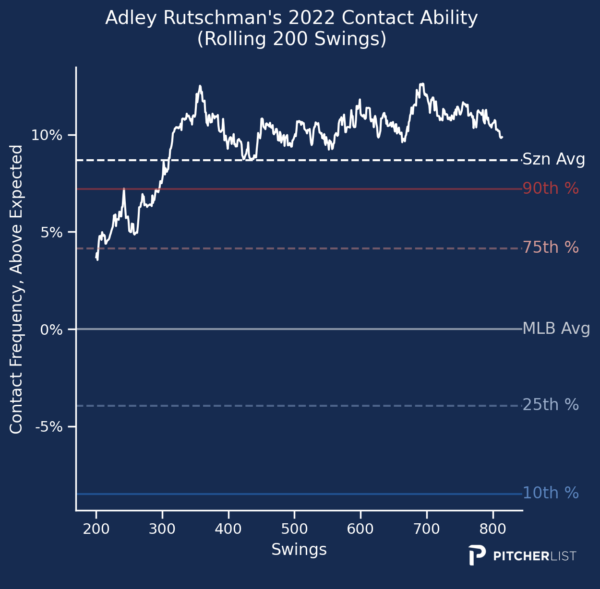
6. Alejandro Kirk (TOR), C
Speaking of rolling charts, I’d be remiss if I didn’t open the discussion on Kirk with this one:
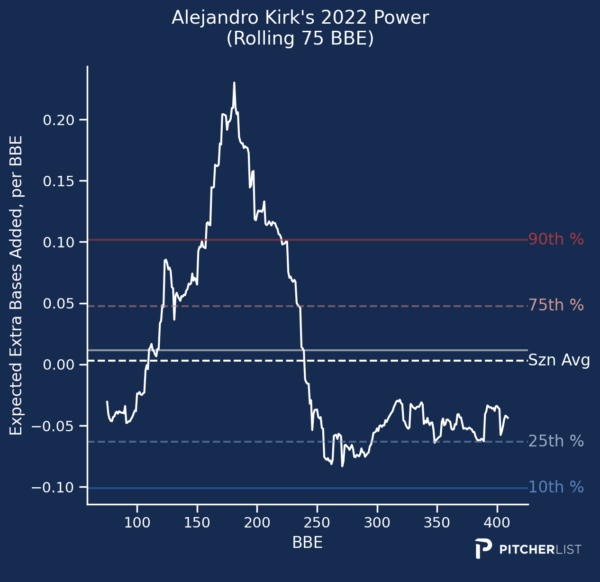
After putting on a fireworks show early in the season, Kirk’s power evaporated with no sign of return. His contact ability dipped as well, but stayed pretty darn strong:
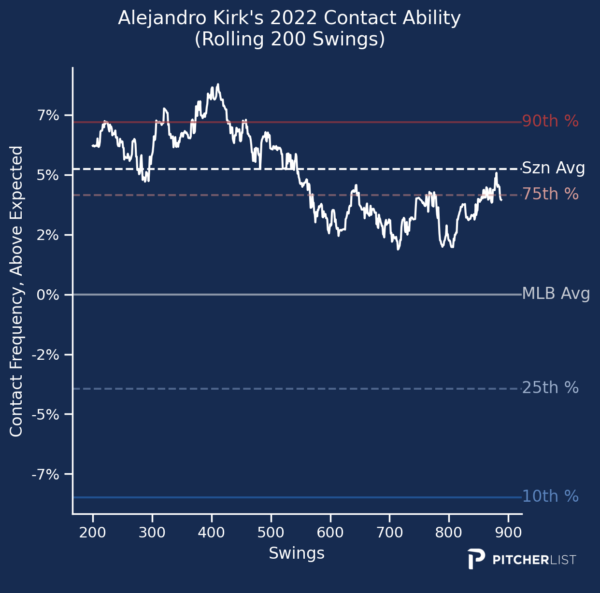
There are two explanations for this: first, it was a fluke. He flashed power he’s never really shown at any level for several weeks, then returned to his usual baseline. The other is that Kirk really did unlock something new, but struggled to adjust to being attacked in different ways, as laid out by Chris Black from Sportsnet in a recent Twitter thread.
Interestingly, Kirk didn’t really get more aggressive, and he started making better decisions later in the season compared to when he was displaying the plus power:
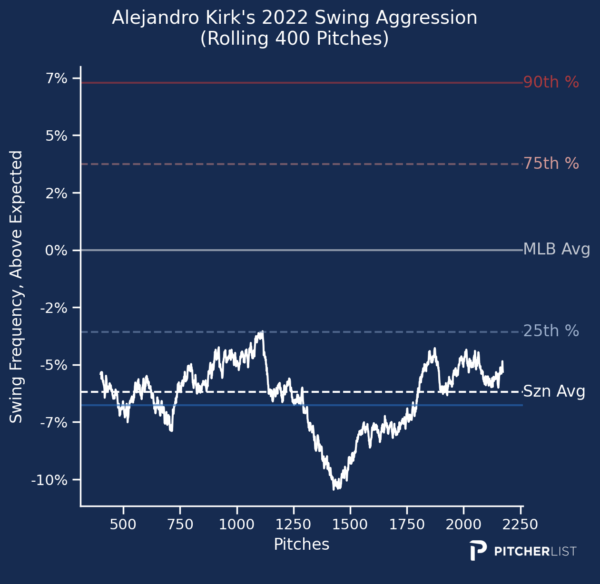
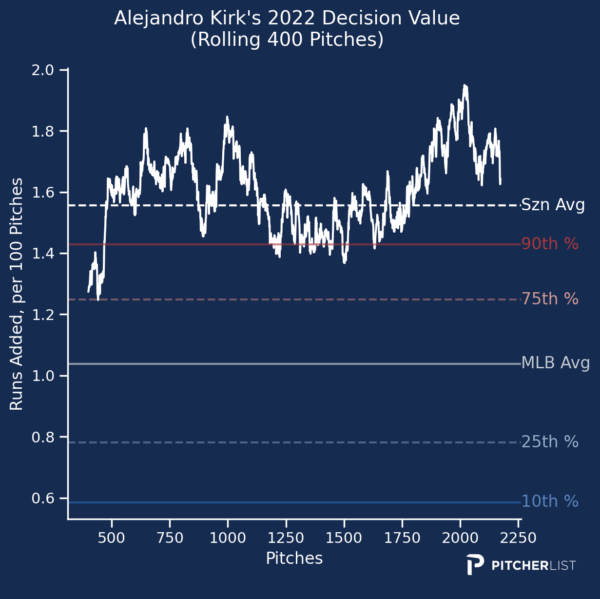
So what do we make of this? Well, I think Chris Black’s narrative is a compelling one—pitches may have simply found some effective ways to attack Kirk to limit his power and force him into more of a slap hitter. That player is still valuable in fantasy, but if Kirk can’t adjust, he’d be more like a Tier 4 catcher than a Tier 2 catcher.
I’m willing to rank Kirk here because I believe in his hit tool and because I believe that he can make some adjustments over the offseason against inside pitches and pitches low in the zone. He doesn’t need to be the supreme power hitter we saw early in the summer—instead, he just needs to be a 17-20 home run hitter in the middle of that dangerous Blue Jays offense who hits .275. I think he can do it, but there’s definitely risk that he’s just barely better than a streamer in 12-team leagues.
Tier 3
7. Willson Contreras (STL), C
The batting average isn’t what it used to be, and neither is the color of his jersey, but Willson Contreras remains as dependable as they come for a fantasy catcher. He has at least 20 home runs in each of his last three full seasons and in four of the last five along with at least 50 runs and 50 RBI in all five full seasons of his career.
Going from Wrigleyville to St. Louis might be a bit of a shock at first for Contreras—he’s been a part of the Cubs organization since he was 17 years old, which is nearly half of his life—but there’s little reason to believe that Contreras can’t be the productive player he was up until this point. I’m quite encouraged by the career-best 21.1% strikeout rate in 2022 after he posted a career-worst 28.6% in 2021. Rolling charts back up my belief that the 2021 strikeouts were just a blip on the radar:
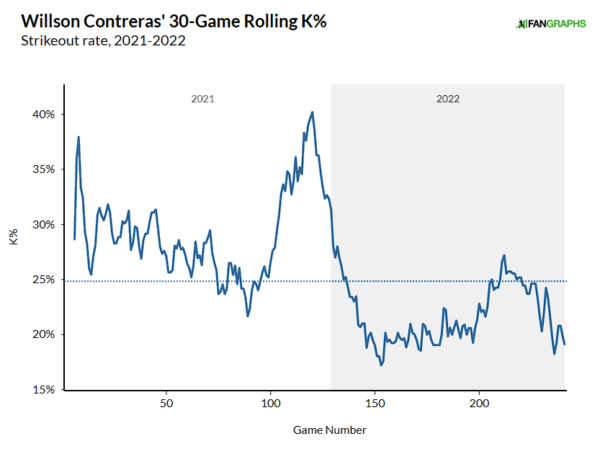
With that in the past, Contreras should be a dependable (if a bit boring) catcher with 20-23 home runs, a batting average that doesn’t hurt you, and a decent amount of counting stats (you know, for a catcher). That reliability and floor is much harder, if not impossible, to come by as we descend these rankings.
8. MJ Melendez (KCR), C/OF
Melendez should never start in a fantasy outfield. As a catcher, though, he brings unique value thanks to his combination of raw power and the fact that he’s projected to lead off for the Royals. Few catchers have any chance at matching Melendez’s plate appearances if he stays healthy, and given 120-130 games, Melendez could lead all catchers in runs scored.
Of course, his batting average does not compare favorably to non-catchers (.217 in 2022, and likely capped around .240 or so in 2023), but his 20-23 home run power and .315-.325 OBP certainly do, and Melendez is an excellent addition to any roster where you’d rather lock in a catcher than try to play the streaming game, which is becoming more and more difficult to do as the benchmark for a starting catcher in 12-team leagues continues to rise thanks to the young talent entering the league.
Lastly, I like seeing that Melendez became less aggressive at the plate as the season went on, particularly because he’s not exactly carrying an elite hit tool.
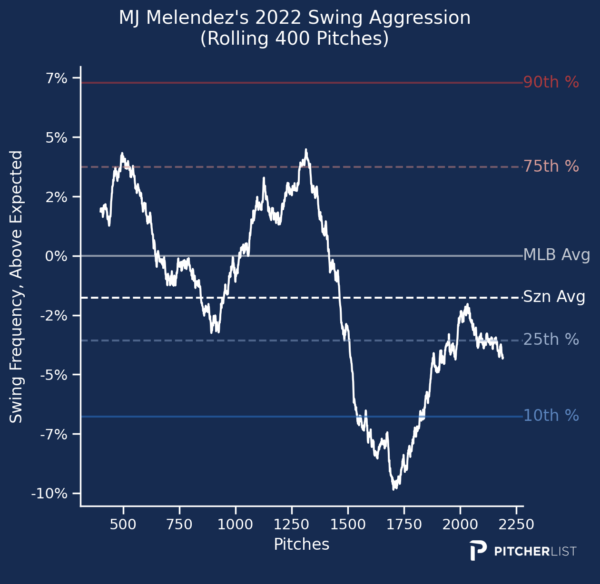
The reduced aggression seems to have helped a bit with his plate discipline, as his dips in aggression align fairly closely to when he had his best strikeout-to-walk rates (note that the x-axis on these charts is very different, but every 250 pitches are roughly equal to 15 games based on Melendez’s 17 pitch-per-game average):
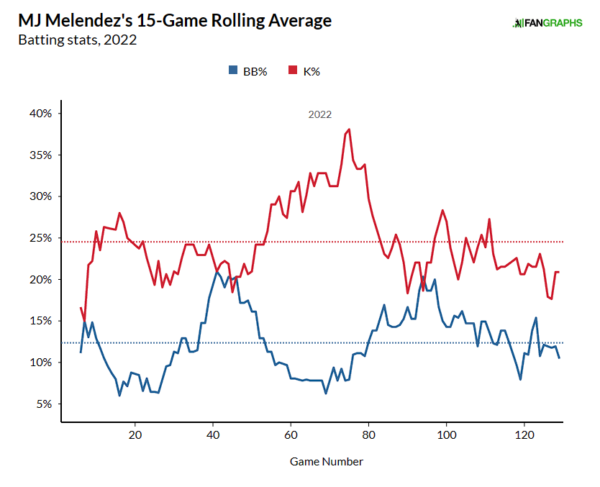
9. William Contreras (MIL), C
Through his first 153 career games, Contreras has shown premium power for a backstop (28 home runs) and solid ratios (.260/.338/.506) and should be a very solid addition to the Brew Crew as their primary backstop after being traded by Atlanta. Contreras projects to hit right in the heart of Milwaukee’s batting order, and the basic elements of a strong fantasy catcher (power, batting average, a primary role, and a spot in the top half of the lineup) are all there.
I find myself hesitant, though, to rank Contreras at the top of this tier. My trepidation stems from his contact ability. In short, it’s not very good:
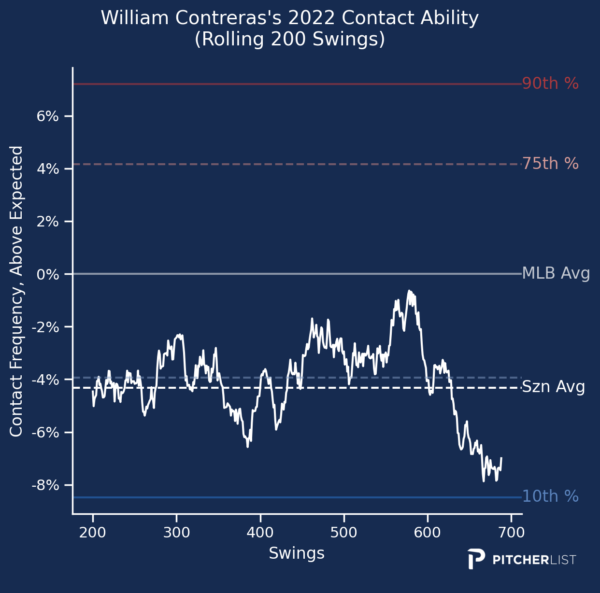
Not only did Contreras spend the entire season below the MLB average, but he took a hard dip toward the end of the season. While a single dip doesn’t necessarily suggest a new trend (it looks a little more dramatic since it came directly after a season-high), Contreras’s poor decision-making in two-strike counts paired with that significantly-below-average contact ability led to a rather stark split between his walk and strikeout rates that widened towards the end of the season:
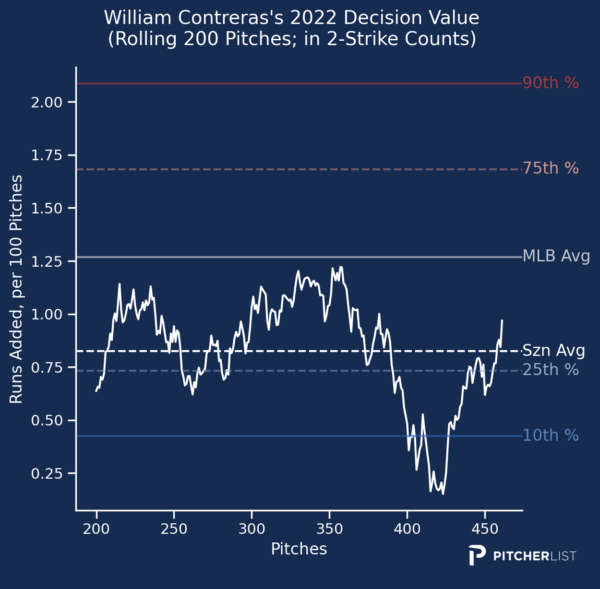
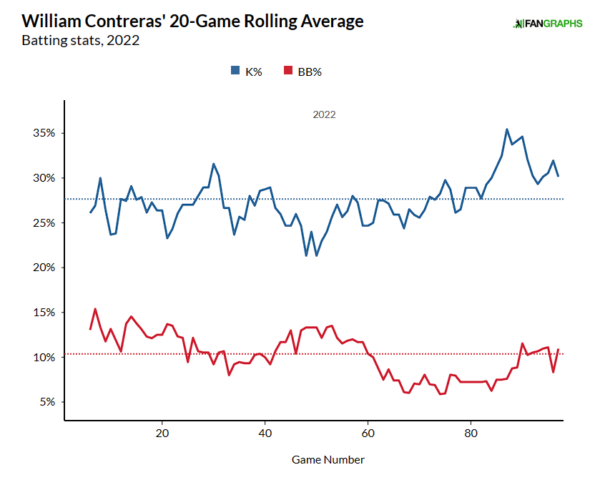
The power and lineup position keeps his floor high enough to stay in this tier, and Contreras’s ability to barrel the ball when he does make contact gives him a ceiling that could move him to the bottom of Tier 2. That said, Contreras needs to improve his decision-making in two-strike counts or improve his contact ability (or both) to reach that potential. Otherwise, he may look more like a 20-22 home run bat with a .240 batting average, which is fine, but also firmly in this tier and not much higher.
10. Sean Murphy (ATL), C
Murphy has a few things going for him that he didn’t have heading into 2022. First, he’s out of Oakland, and that’s a pretty big deal when you consider the weakness of that lineup, the cavernous nature of that home ballpark, and its massive foul territories. Second, he’s in Atlanta, which is not only a much better team with a much friendlier ballpark, but it also is a team who has an opening at DH, which helps Murphy pad his plate appearances even when he needs a day off from behind the dish.
Oh, and the friendlier ballpark thing can’t be understated—Oakland Coliseum is by far the worst park for right-handed power, sporting a league-worst park factor, wOBAcon factor, and home run factor for righties in all of baseball. The home run factor is particularly bad—the 70 home run factor means it’s 30% worse than the league average, significantly below parks like Oracle Park, Kauffman Stadium, PNC Park, and Comerica Park. Oakland is just a really difficult place to hit home runs. For what it’s worth, Truist Park in Atlanta plays pretty neutrally across the board for righties.
While Atlanta has featured a pretty evenly-split workload at catcher for the last few seasons, most recently between Travis d’Arnaud and William Contreras, Murphy is a much better defender overall than either one. He is among the league’s best at framing and pop time according to Statcast, finishing in the top six in framing, and in the top four in pop time in each of the last three seasons.
With an improved strikeout rate in 2022 to go along with the improved environment and supporting cast, Murphy definitely belongs as one of the ten catchers who should be rostered all season long in all formats. His floor is likely higher than some of the others in their tier, but even with ample playing time, his power and batting average cap his ceiling a bit lower than the rest of the tier.
Tier 4
11. Cal Raleigh (SEA), C
The Big Dumper hit an astounding 27 home runs in 119 games for the upstart Mariners last season but did so in a way that may remind you of other hard-hitting catchers of yesteryear who have faded from relevancy as the power came with a near-30% strikeout rate, a .211 batting average, and a .284 OBP.
I truly hope that Raleigh doesn’t trend in the direction of hitters like Gary Sánchez, who eventually lost the ability to even keep a batting average above .200, and with some digging, I did find a few promising trends that give us hope that Raleigh can hit just enough to make that power worth rostering thanks to a huge spike in good decision-making and improved strike zone judgment with two strikes in the last chunk of the season that also came with a spike in power. If Raliegh can keep even just some of these late-season gains, he’ll perform as well as any Tier 2 catcher.

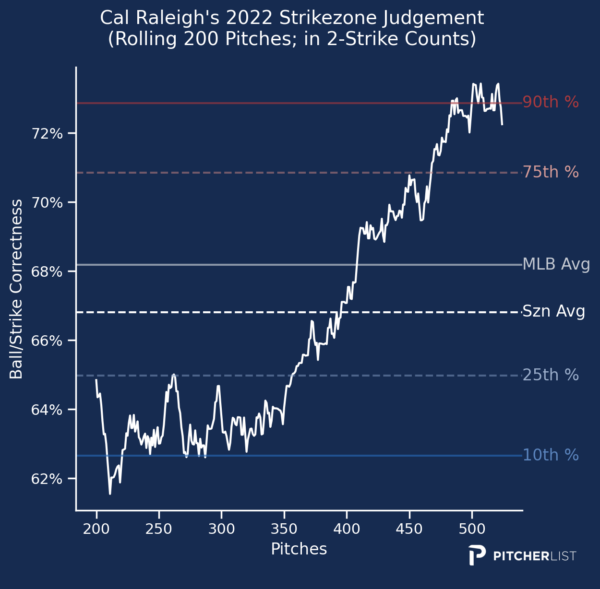

12. Tyler Stephenson (CIN), C
After a bit of a breakout in the 2021 season, Stephenson continued to roll to start 2022, hitting .305/.361/.468 through 42 games with five home runs and ample counting stats (though he missed nearly two weeks at the end of April with a concussion). Unfortunately, Stephenson broke his thumb in early June, missing a month of action. He looked strong upon his return in July, hitting .400 with a home run and double over eight games, but injury struck yet again as Stephenson broke his collarbone, costing him the rest of the season.
If healthy, Stephenson’s role as the primary catcher for the Reds is quite clear, and he could be a source of about 15-17 home runs and a .260 batting average, plus about 130-140 combined runs and RBI. Broken bones don’t generally have the same recurrence issues as torn tendons or ligaments, though Stephenson’s injury history so far in the major and minor leagues is a bit concerning as he’s dealt with multiple hand and wrist injuries as well as concussions.
At this point, you’re really shooting for upside at catcher, and Stephenson definitely has the upside to be a top-10 catcher. Be prepared to need to dip into the free agent pool or waiver wire at times if/when Stephenson hits the IL, but the 26-year-old should probably be drafted in all 12-team leagues.
13. Travis d’Arnaud (ATL), C
Assuming Atlanta gives d’Arnaud another 100 games as they did in 2022, you can likely expect another 15-18 home runs and hopefully a .250 batting average from the 34-year-old veteran (by the way, happy birthday, Travis—he turned 34 on the day this article published).
d’Arnaud doesn’t really care to walk much, taking a free pass in just 4.7% of his plate appearances in 2022, but usually generates enough contact to be neither a hindrance nor a help in ratios while accumulating enough stats to be slightly better than replacement level. There’s really not much upside to be found—even considering he set career-highs in home runs and runs scored in 2022—due to the acquisition of Sean Murphy, but with few challengers for DH at-bats on the roster, d’Arnaud should make for a decent-enough fantasy catcher for those who don’t really care to draft one before the final round.
14. Keibert Ruiz (WAS), C
Ruiz has a starting role, a strong hit tool, and a spot near the middle of a lineup (albeit a bad one in Washington), and that creates enough floor to consider him with your last pick in a 12-team draft if you don’t have a catcher. There’s even some upside here, as Ruiz did hit 21 home runs in 72 games at Triple-A in 2021 and should be at least above average in batting average and OBP as he continues to develop at the major league level. The six stolen bases were intriguing too, especially considering he hadn’t stolen a base at any level since his rookie league debut in 2015.
If Ruiz, who should have an excellent strikeout-to-walk ratio, can hit .280 with 10 home runs and seven or more steals (thanks to the new base sizes) while playing 120 or more games, he’d be a threat to make Tier 2. He hasn’t actually done any of those things yet in a single season in the majors, though, and his upside is probably not much more than being a .280-.290 hitter with 12-14 home runs and up to eight steals. That’s pretty good, but considering that’s his upside, he’s best reserved for points leagues (where his contact makes more of an impact) or in situations where you really just want a safe catcher (like a two-catcher format).
15. Danny Jansen (TOR), C
There’s 20-home run power in Jansen’s bat, assuming he can get to 100 or more games played, and the improved plate discipline in 2022 was an intriguing development as he walked 10.1% of the time while striking out just 17.7% of the time. The trade of Moreno should improve Jansen’s shot at getting to those 100 games, though if Brandon Belt stays healthy for most of the season, Jansen would find himself on the short side of a platoon, forced to split time with Kirk at catcher against right-handed pitching.
If I knew Jansen would get 500 plate appearances, he’d either be at the top of this tier or at the bottom of Tier 3, but without that kind of job security, it’s hard to look at Jansen as more than a dart throw in single-catcher formats.
Tier 5
16. Gabriel Moreno (ARI), C
The supporting cast and ballpark aren’t quite as good in the desert as they were in Toronto, but at least the highly-touted catching prospect has a much clearer path to playing time with the Diamondbacks. Moreno’s calling card is his hit tool, as he slashed .315/.386/.420 in 267 plate appearances in Triple-A and .319/.356/.377 in his 73 plate appearances in the majors last season.
Those slash lines plus the scouting reports suggest that Moreno may not be a threat to hit 20 dingers, but if he somehow finds his way to mostly regular at-bats (Carson Kelly hasn’t exactly been the healthiest catcher), Moreno should provide a very stable batting average and OBP floor, which is not easy to find at catcher in any tier, particularly these lower ones.
17. Shea Langeliers (OAK), C
The 34.6% strikeout rate is scary, but Langeliers did swat 25 home runs across 132 games between Triple-A and the majors last season, and Oakland appears committed to giving the young backstop a lot of plate appearances in 2023. I could see Langeliers hitting 18-20 home runs in a full season of work and maybe even getting 100 combined runs and RBI depending on his spot in the batting order, but he’ll need to take big steps forward in his plate discipline before I consider him anything more than a streamer, especially in Oakland Coliseum.
18. Joey Bart (SFG), C
The Giants still have some hope that Bart can be their long-term catcher of the future, though it will require Bart to clean up the high strikeout rates he’s posted in the minors and majors the last few seasons. There was a point last season when Bart was striking out less than 25% of the time, though it only lasted for about two weeks before the strikeout rate spiked back up to 35-40%.
If Bart shows improved discipline in the spring or early in the season, he could be a 15-home run hitter with a workable batting average based on tools he showed earlier in his career. Until then, though, Bart remains a streamer limited to whenever the Giants go to Colorado.
19. Mitch Garver (TEX), C
If Garver plays, he could hit as many as 20 home runs for the Rangers and walk enough to be useable in OBP leagues. Heck, the power and counting stats could even make him intriguing in standard leagues.
The problem, of course, is that Garver hasn’t played. He has just 122 games to his name since the start of 2021, and while he did flash 31 home runs in 2019, that was the ol’ rabbit ball year. He has 26 home runs in those 122 games he’s played, though, indicating he could hit 20 more if he played 100 games. It’s just hard to count on that from a player with just one season with 100 games at the major league level.
Tier 6
These blurbs are about to get a lot shorter, as few of these catchers are particularly interesting on draft day in single-catcher leagues.
20. Eric Haase (DET), C/OF
Since the start of 2021, Eric Haase is eighth among all catchers in home runs (36) and RBI (105). You’d think that would make him a good source of home runs and RBI, but unfortunately, it doesn’t, really. Much of Haase’s production comes from good ol’ fashioned accumulation, as he is also 15th in games played. Haase does hit plenty of pulled flyballs, which is a solid recipe for home runs, but his extreme aggression at the plate (see below) and a worrying drop in barrel rate, exit velocity, max exit velocity, and hard-hit rate make it hard to see how Haase ever resembles the 2021 version of himself again. Additionally, the trade of Soto to the Phillies brought in two utility players and a catcher, all of which can cut into Haase’s plate appearances (Haase was playing about 20-25 games in the outfield or at DH).
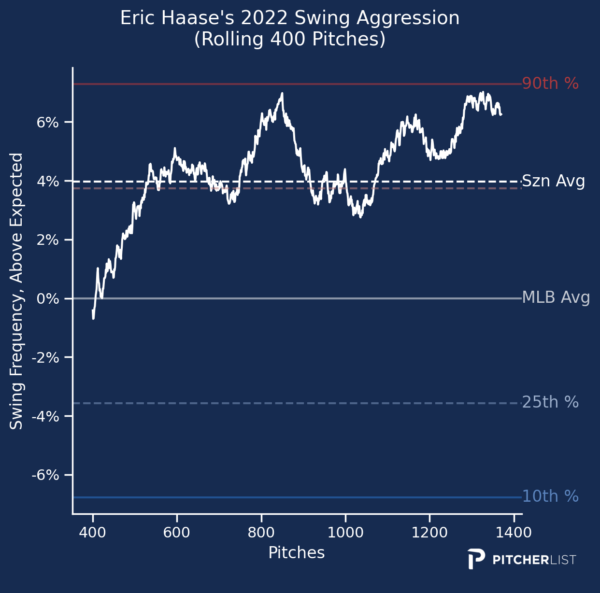
I’d be stunned if he hits better than .230 in 2023, and if any of the young bats in Detroit start to heat up, Haase will quickly find himself near the bottom of the order.
21. Yasmani Grandal (CWS), C/1B
Grandal’s age-33 season did him no favors as he hit .202/.301/.269 in 99 games with just five home runs. Sure, I suppose OBP leaguers might take a flyer on him as a second catcher as he still posted a double-digit walk rate, but his injury risk, performance risk, and discouraging trends make him a rather unexciting option at best.
22. Mike Zunino (CLE), C
You know the drill—Zunino gets playing time for teams due to his plus defensive abilities behind the plate, but his .183 batting average and .257 OBP over his last 871 plate appearances since the start of 2019 are absolutely brutal, even though it could come with a boatload of home runs (he hit 33 in 2021). If you’re absolutely punting batting average, like in a two-catcher league with a head-to-head categories format, I suppose you can chase the power upside for your second catcher, but if you care at all about ratios, Zunino is a tough sell.
23. Christian Vázquez (MI ), C/1B
We now know that the 23 home runs in 2019 were a product of the ball as opposed to his bat and that even with plenty of playing time, Vazquez is unlikely to hit more than eight or nine dingers. He doesn’t really run anymore either, making Vazquez mostly a source of empty batting average that’s somewhat useful as a streamer or second catcher in points leagues from time to time, or as an injury fill-in second catcher when ratios matter.
24. Gary Sánchez (FA), C
At this stage of his career, Sanchez has settled in as a guy who a team might employ for about 80 games to hit 15-17 home runs and hopefully hit above .200. Health has been a bit better for Sanchez in recent years, as he’s played in at least 117 games for two consecutive seasons, I suppose there could be some reason he becomes interesting in a single catcher league, such as signing with Colorado, but seeing as Sanchez is still looking for work at the moment, it’s getting harder and harder to see a meaningful role for him in 2023.
25. Elias Díaz (COL), C
Díaz is the Rockies’ primary catcher, and as a result, should put in another 50 games with a .270/.312/.471 line like he did at home in 2022. He’s worth streaming at home if you’re streaming catchers throughout the season, and must absolutely go back on the wire when he’s on the road (.186/.251/.266 on the road in 2022). Díaz isn’t exciting, but at least he’s predictable.
26. Austin Nola (SDP), C
Nola makes plenty of contact, limits strikeouts, and plays when he’s healthy. He’s one of few catchers in this tier who could feasibly post a batting average better than .260 and an OBP better than .330, too. Points league players could find some use for that, and his floor is rather high compared to his peers (assuming he stays healthy, which does not happen often).
Of course, that floor comes with absolutely no ceiling—even a healthy Nola likely falls short of 100 games played, and it could be even less if Luis Campusano makes progress at the big league level. He’s also a good bet to slug well below .400, and I’ll take the under on 70 combined runs and RBI.
27. Logan O’Hoppe (LAA), C
O’Hoppe raked in Double-A last season, hitting 26 home runs with about as many walks as strikeouts in 104 games in the Phillies and Angels’ systems. The plate discipline should serve him reasonably well in the big leagues, and I’d say he’s a threat to hit 10-12 home runs with a neutral batting average and OBP. The issue is that we’ve seen so little of him in the majors and Triple-A, and he’s likely to split time somewhat evenly with veteran Max Stassi at the bottom of the Angels’ lineup.
O’Hoppe was a top-100 prospect last year in some circles, though, and those in dynasty leagues should at least be happy that there’s a chance O’Hoppe is a passable second catcher in two-catcher formats as soon as this season. That said, catchers have extremely high learning curves, and very few find success in their rookie season.
28. Jonah Heim (TEX), C
Heim was surprisingly good in 2022, hitting 16 home runs in 127 games, though it came with a .227 batting average and a .298 OBP. That production was quite front-loaded, however, as Heim struggled mightily in the second half, batting .181/.279/.311 over 57 games with a truly demoralizing 19.7% infield flyball rate.
The hopeful return of Mitch Garver will likely cap Heim’s playing time, and prospect Sam Huff could also put pressure on Heim if Huff can hit like he did last season in Triple-A when he smacked 21 home runs in 63 games. The strikeout rate for Huff is ugly, sure, but it’s not as though Heim is hitting for a high average either.
29. Francisco Álvarez (NYM), C
Álvarez is a top-20 prospect in baseball thanks to his prodigious power and patience at the plate, though as I’ve mentioned before, catching prospects can take considerable time to develop into decent hitters in the major leagues due to the tough learning curve (it’s sort of like rookie tight ends in football if you’re into that sort of thing).
Álvarez should begin the season in Triple-A, and if it goes as well as or better than it did last season (121 wRC+ over 45 games), the Mets will probably call him up to replace Tomás Nido as the platoonmate for Omar Narváez at the bottom of the order. He doesn’t need to be drafted in redraft leagues, as you don’t generally have room on your bench for a backup catcher with an uncertain start date, but he’s worth keeping an eye on and will likely be a hot commodity when his call-up approaches. If the top three tiers at catcher weren’t deeper than they’ve been in a decade, Álvarez would likely be higher up this list.
30. Endy Rodriguez (PIT), C
Another catching prospect, Rodriguez is more of a hit tool guy than a power bat (though he did hit 25 home runs in the minors last season). The Pirates are a maddening organization who will almost certainly take way too long to promote Rodriguez to the major league roster, but if and when they do, we could see Rodriguez at least provide strong ratios (for a catcher) and maybe even a .400 slugging percentage. Again, catching prospects have a hard time adapting to the majors for a variety of reasons, so you can’t really draft him except MAYBE in draft and hold formats (where almost anyone is draftable), but at least keep the name in mind if the Pirates decide to not be the horrible misers they usually are and give the guy a shot in the big leagues.
Photo by Icon Sportswire | Adapted by Doug Carlin (@Bdougals on Twitter)

FYI, Christian Vazquez signed a 3 yr deal with the Twins last December. Surprised you didn’t catch that seeing this article was posted on Feb 7th.
This was fixed. Just had to change the first sentence. Totally slipped my mind because, well, Vazquez isn’t that interesting in fantasy regardless of where he lands.